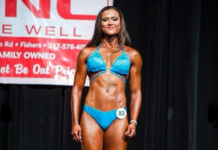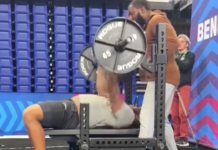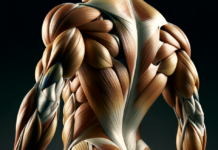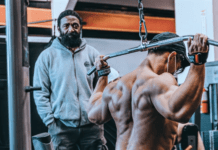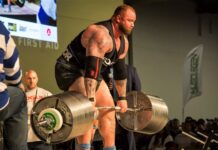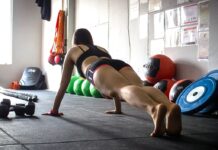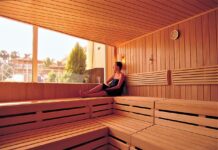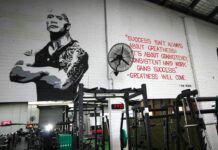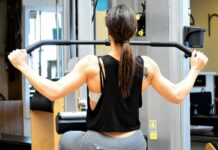Workouts are full of negatives. Every up has a down. Every ascent has a descent. Every contraction has an extension. There are two sides to every rep, and, if you slow it down enough, the negative half can stimulate growth just as the positive half does. We discuss the positives of going negative.
WHAT IS ECCENTRIC TRAINING?
The concentric (positive) halves of reps are when the muscle contracts. Conversely, the muscle lengthens during the eccentric (negative) halves of reps. The former occurs when raising the weight and the latter when the weight is lowered, but during all of that time—assuming you don’t simply drop the weight—your muscles remain under tension. Furthermore, you’re approximately 25% stronger during the negative halves of reps than during the positive halves. In other words, if you can bench press 240 pounds, you can lie on a bench and slowly lower a bar to your chest weighing 300 pounds.
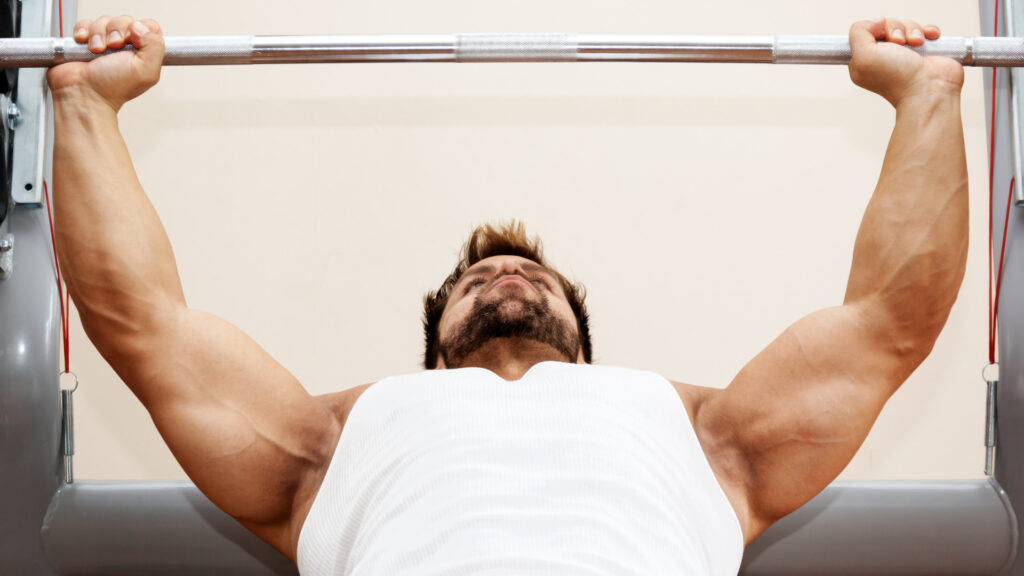
On many lifts, you should focus more on the negative. Spend three seconds lowering each rep. This is especially effective for isolation exercises like biceps curls and leg extensions, as opposed to compound exercises. Still, that extra strength you have on the eccentric explains why, even if you go slow, you don’t usually feel your muscles working as hard on the descent as the ascent. To truly go negative, you need to erase the strength imbalance and make the eccentric halves harder. Let’s explore three methods of doing eccentric training.
HOW TO BEST DO ECCENTRIC TRAINING
Method #1: Beyond Failure
Do 6-10 reps and stop only when you can’t grind out another rep on your own. Then have a spotter help you raise the weight. From this point on, it’s okay if the spotter does more work than you, because you’re no longer focused on the positive. You’re now all about the negative. While maintaining strict form, lower the weight slowly, taking approximately 6 seconds for the descent. Do 2-5 of these negative reps. In effect, you use 100% of your positive strength on the 6-10 positive reps and then use that extra 25% negative strength on the 2-5 negative reps, pushing yourself well beyond positive rep failure.
Method #2: Forced Positive
You can also do entirely negative sets. Select a weight that’s approximately 25% greater than what you’d use for a regular set of 8 reps. Have a spotter do most of the lifting on the concentric halves of reps. Your focus will be on the eccentric. Lower the weight slowly and controlled over 6 seconds. Do 6-10 such negative reps.
(On some machine exercises, you can do this without any assistance by lifting the weight bilaterally and lowering it unilaterally. For example, on the leg extension, raise both legs but then lower one leg. You can either alternate legs or do 6-10 reps with one leg and 6-10 with the other.)
Method #3: Forced Negative
So far, we’ve focused on reducing stress on the positive halves of reps so you can ramp it up on the negative halves. Alternately, you can increase stress on the negative. These are, in effect, reverse forced reps because the spotter makes the reps harder instead of easier. He pushes or pulls down on the weight during the negative portions while you resist gravity’s pull, purposely going slow.
For example, on pulldowns, you’ll bring the bar down on your own (or the spotter can help you). Then, as the weight stack lowers and the bar rises, the spotter pushes down on the bar, increasing resistance. The key is for the spotter to add just enough to make the negative harder but not so much that you can’t smoothly but slowly lower the weight over approximately five seconds. With experience, a training partner should be able to add just enough to negative reps to make them about 25% harder.

BENEFITS OF ECCENTRIC TRAINING
The benefits of eccentric training are supported by scientific research:
Muscle Growth: A study published demonstrated that focusing on eccentric training can lead to greater muscle hypertrophy compared to concentric training alone [1].
Strength Gains: Eccentric training has been shown to produce significant strength gains. A meta-analysis found that eccentric resistance training with its focus on heavier weights led to greater strength improvements compared to concentric training [2].
Muscle Endurance: Eccentric training can improve muscle endurance. A study showed that eccentric exercise increased endurance and delayed fatigue [3].
Injury Prevention: By enhancing muscle resilience and reducing muscle imbalances, eccentric training can play a role in injury prevention [4].
ECCENTRIC TRAINING BASICS
You’re approximately 25% stronger on the eccentric halves of reps than the concentric halves.
Negatives can be used to extend a set beyond full-rep failure.
A forced positive is when resistance is reduced on the concentric so you can focus on the eccentric.
A forced negative is when resistance is added to only the eccentric.
ECCENTRIC TRAINING TIPS
In most cases, you need a spotter to help add or reduce resistance.
Some machine exercises can be done alone by raising the weight bilaterally and lowering it unilaterally.
Negatives are inappropriate for exercises that are difficult to spot, such as the deadlift.
Machine exercises are typically safer and easier to spot during negatives. For example, we do not recommend negative reps of free-weight squats, but you can do negative squat reps with a hack or Smith machine.
Even if you train alone, slowly lowering the weight during the negative halves of reps can be beneficial.
ECCENTRIC TRAINING FAQS
What is concentric vs eccentric training?
The concentric half of a rep is when muscles contract. The eccentric half is when muscles lengthen. During a pulldown, for example, the concentric rep half is when the bar is pulled down and the weight stack goes up. The eccentric half of that same pulldown is when the bar goes up and the weight stack does down. Usually, the concentric half of a rep comes first, but not always. During a squat or bench press, the eccentric half comes first (lowering the weight) and the concentric half comes second (raising the weight).
What is the difference between eccentrics and negatives?
There’s no difference. Negative is a synonym for eccentric.
Does eccentric build more muscle?
Yes. It’s been shown to. Certainly, if you’re not used to focusing more on the negative halves of reps this may spark more growth.
Why is eccentric better for muscle growth?
It’s not necessarily better than concentric long-term. However, it is productive to focus on both the concentric and eccentric halves of reps.
Can eccentric resistance movement alone build muscle?
Yes. It’s resistance training and will stimulate muscle growth. Some have shown results focusing only on eccentric training. This was a bit of a fad in the 1980s among strength coaches. However, we don’t recommend this as a long-term strategy. Focus on the concentric and eccentric halves of reps.
Why is eccentric stronger than concentric?
When a muscle is lengthening while activated, it produces significantly more force and requires less energy than a muscle contracting isometrically (constant muscle length) or concentrically (active shortening).
Is eccentric more important than concentric?
No, they’re both important. Forced to choose, we would say the concentric is most important. After all, that’s what weight-lifting is all about.
What are examples of concentric and eccentric movement?
Let’s take the barbell curl. The concentric movement is the curling of the weight up, from arms straight to arms flexed. The eccentric movement is the lowering of the weight back to the starting position, from arms flexed to arms straight.
What is an example of a concentric and eccentric exercise?
There are a lot of concentric exercises, as long as you don’t resist the lowering of the weight. Deadlifts are one good example. Power cleans are another. But it could be almost any exercise—curls, shoulder presses, leg extensions, etc.—if you let gravity quickly pull the weight back down. As for purely eccentric exercises, these will require some modifications. A training partner to raise the weight is a big help. An example of one you can do yourself is the eccentric dip: Slowly lower yourself from the top to bottom position, resisting gravity’s pull, and then stand on the step to return to the top position to slowly lower yourself again.
SOURCES
1. Higbie, E. J., Cureton, K. J., Warren III, G. L., & Prior, B. M. (1996), “Effects of concentric and eccentric training on muscle strength, cross-sectional area, and neural activation,” Journal of Applied Physiology, 81(5), 2173-2181.
2. Roig, M., O’Brien, K., Kirk, G., Murray, R., McKinnon, P., Shadgan, B., & Reid, W. D. (2009), “The effects of eccentric versus concentric resistance training on muscle strength and mass in healthy adults: a systematic review with meta-analysis,” British Journal of Sports Medicine, 43(8), 556-568.
3. Morgan, D. L., & Proske, U. (2000), “Eccentric exercise,” European Journal of Applied Physiology, 81(6), 486-500.
4. Ebben, W. P., & Jensen, R. L. (2004), “Strength training for women: Debunking myths that block opportunity,” The Physician and Sportsmedicine, 32(5), 1-9.
